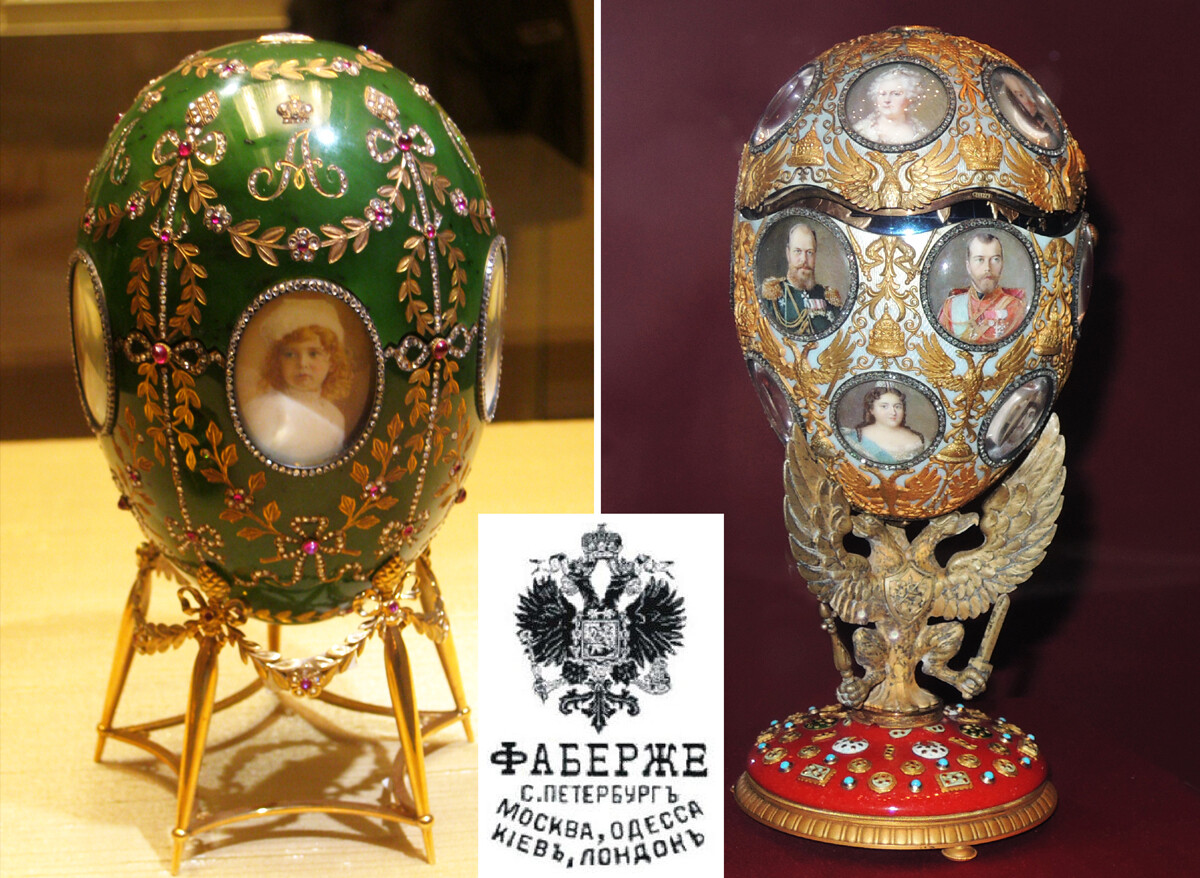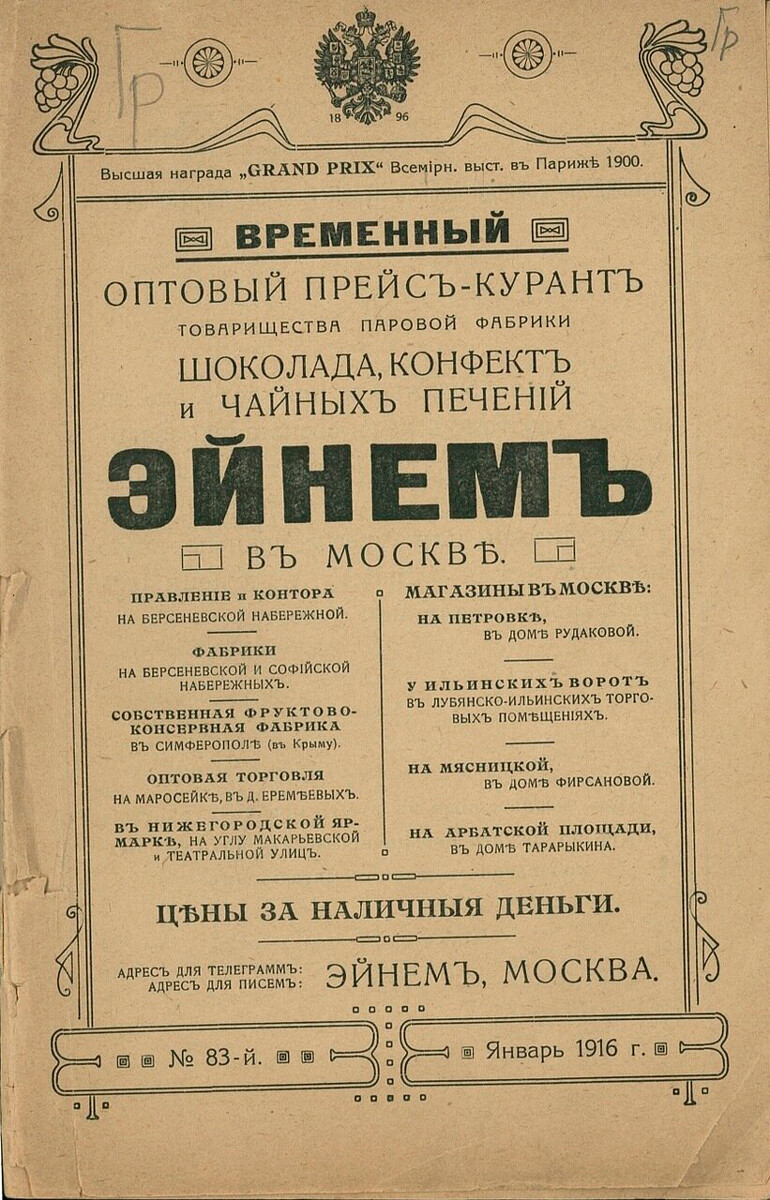10 main suppliers to the Russian imperial court (PHOTOS)

The needs and desires of the imperial court in Russia were served by a veritable ‘army’ of merchants and private manufacturing companies. Always careful to provide the highest quality, they produced a variety of luxury goods and household items – confectionery, jewelry, food and alcohol, furniture and other things. They catered to the emperor and all members of the imperial family, meeting all their whims and needs.
Starting in the first half of the 19th century, those who cooperated on a regular basis and performed their work impeccably had the honor to be awarded the title of “Supplier to the Court of His Imperial Majesty”. This was a supreme honor and very prestigious, and the merchant was given permission to place the Russian imperial coat of arms on their logos and advertisements. In addition, it was incredibly profitable as the Romanovs didn’t spare any expense for their lavish lifestyle. However, it was possible to be deprived of this title; in particular, if the firm changed ownership or if the supply became irregular, unreliable and lacking in quality.
There were several dozens of official imperial suppliers, among which were foreign merchants and firms: these included Michelin tires, watches by Tissot and Breguet, and cars made by Germany’s DMG.
Let’s take a look at the high-end goods that were produced by the most famous suppliers to the court of the Romanovs.
1. Faberge jewelry
 The Alexander Palace Egg and The Romanov Tercentenary Egg by Faberge
The Alexander Palace Egg and The Romanov Tercentenary Egg by Faberge
More than 150 years since the company was founded, Faberge’s name is still well known around the world. For more than 30 years, from 1885 to 1917, the jeweler created the famous Easter eggs that were ordered by Alexander III, and then Nicholas II, who gifted them to their wives (and mother, in the case of Nicholas).
 The folding triptych icon by Faberge
The folding triptych icon by Faberge
In addition, the Faberge firm made a variety of finely-crafted jeweled items for the imperial family – luxurious ashtrays, cigarette cases, vases, precious icon frames, clocks, cups, tableware and much more.
2. Enamels by Pavel Ovchinnikov
 Dish and salt shaker by P.A. Ovchinnikov's firm
Dish and salt shaker by P.A. Ovchinnikov's firm
The history of this Moscow jeweler is a real rags-to-riches success story. He was born into a serf family that worked for a noble landowner who saw that the young Ovchinnikov had great talent. So, the owner sent him to a special school to study jewelry making. Ovchinnikov did very well in his studies and began his own business, which was so successful that he was even able to buy his own freedom from his noble owner.
 Candy vase and jam vase with removable lid and spoons
Candy vase and jam vase with removable lid and spoons
Ovchinnikov opened his own factory, and his items were distinguished by the fact that they were made with enamel – tableware sets, drinking vessels, salt shakers, vases, etc – were noticed and appreciated by Alexander III while he was still a prince. As a result, Ovchinnikov’s firm earned the title of “supplier to the imperial court” for more than 40 years. Read more about Ovchinnikov here.
3. Watches by Pavel Bure
 Mantel clock by Pavel Bure firm
Mantel clock by Pavel Bure firm
From 1899 until 1917, the Pavel Bure Trading House was nearly the only company that supplied watches to the Imperial household.
 Mechanical pocket watch
Mechanical pocket watch
During this time, the company produced several thousand watches of the most exquisite quality – pocket watches, wall clocks, travel clocks and others.
 Pavel Bure
Pavel Bure
After the Bolshevik Revolution in 1917 the business moved to Switzerland and is still known under the Paul Buhre brand.
4. Confectionery products by Alexei Abrikosov
 Abrikosov and Sons production
Abrikosov and Sons production
“Factory and Trade Association Abrikosov and Sons” was one of the main producers of chocolate in the Russian Empire. Abrikosov was the first in Russia to coat dried fruits with chocolate glaze. Previously, such delicacies were only imported. He also produced caramel, biscuits and a variety of candies.
 Factory and Trade Association Abrikosov and Sons
Factory and Trade Association Abrikosov and Sons
The confectionery magnate owned a factory and several stores in Moscow, and in 1899 the company became a supplier to the court of His Imperial Majesty. After the 1917 Revolution, Abrikosov’s factory was nationalized and renamed into “Babaev Chocolates”. That company is still in operation today.
5. Confectionery products by Theodor Einem
 Theodor von Einem production
Theodor von Einem production
Back in the mid-19th century, German confectionery Theodor von Einem opened his own production facility in Moscow. He made lump sugar, caramel, chocolate candies, cookies and other sweet items. The females in the imperial family were obsessed with his sweets, and his wide assortment of goods was a huge success at international exhibitions.
 Theodor von Einem advertising
Theodor von Einem advertising
However, Einem was awarded the official title of “supplier to the court” only in 1913, after the death of its founder. Then the Revolution saw the company nationalized, but since then it has continued under the name of “Red October,” producing delicious chocolate candies that have been loved by generations of Soviet and Russian children.
6. Adolphe Sioux’s cookies
 Sioux candies
Sioux candies
Frenchman Adolphe Sioux tried his hand at perfumery, but he became most famous as the owner of a confectionery business. All across Russia Adolphe opened shops under the umbrella of the trading house A. Sioux and Company, and then later, the firm of his sons S. Sioux and Company.
 Sioux's factory
Sioux's factory
The assortment of their confectionery products was huge: biscuits, cocoa, caramel, marmalade, waffles, gingerbread and much more. In 1913, in honor of the 300th anniversary of the House of Romanov, the company produced its most famous product — Yubileynoye (Jubilee) cookies — and it was soon awarded the title of “supplier to the imperial court”. In Soviet times, the factory was renamed “Bolshevik” and today it’s still making those cookies, which are a very popular brand. Even today, they are the favorite sweet snack of many children in Russia.
7. Perfumes by Alphonse Rallet
 Ivan Bilibin. Advertising for Rallet; A perfume label
Ivan Bilibin. Advertising for Rallet; A perfume label
The French perfumer opened his company in Moscow in 1843. He produced perfume, powder, lipstick, and soap; and then 12 years later he became a supplier to the imperial court;l. In fact, this title was confirmed several times. The perfume bottle by “A. Ralle and Company” featured the double-headed eagle of the Russian Empire.
By the way, the company’s chief perfuneur perfumer, Ernest Beaux, later created the famous Chanel No. 5 for Coco Chanel. Presumably, the basis for this perfume was the fragrance “Bouquet of Catherine”, which he originally created for the tercentenary of the House of Romanov in 1913. (Read more here).
8. Peter Smirnov’s alcoholic drinks
 Smirnov advertising
Smirnov advertising
The Russian vodka brand Smirnoff is well known across the globe. It was first created in emigration, after the 1917 Revolution, by Vladimir Smirnov, the son of Peter Smirnov who had been known as Russia’s “vodka king” during the late imperial era. His factory in Russia produced vodka, wines and liqueurs.
 Smirnov advertising
Smirnov advertising
In addition, Smirnov’s company imported fine wines into the empire. In 1886, he became an official supplier to the imperial court, and was practically a monopolist in supplying the sacramental kagor wines to Russian Orthodox churches and monasteries.
9. Wines from the Eliseev family
 Eliseev's store
Eliseev's store
The Eliseevs are a famous merchant dynasty. In the early 19th century they opened several shops in St. Petersburg (still named Eliseev Emporium on Nevsky Prospekt, one of the city’s finest stores). They traded in imported goods, such as wine, coffee, tea, rice, cheese and more. In 1857, the family founded the “Eliseev Brothers Trading House”.
 Eliseev's cellars of Russian and foreign wines
Eliseev's cellars of Russian and foreign wines
Large amounts of wine were purchased abroad and then shipped to Russia where it was fermented and bottled. The company had a wine cellar on Vasilievsky Island in St. Petersburg, which was considered one of the finest in Europe. The wines fermented by the Eliseevs won international prizes, and starting in 1874 they became official imperial court suppliers.
10. Lev Golitsyn’s sparkling wines
 Lev Golitstyn wine cellar
Lev Golitstyn wine cellar
Prince Golitsyn was a pioneer in the production of sparkling wines in Russia. His ‘champagne’ was even highly appreciated by the French at the 1889 Paris World Exhibition. In Crimea and along the Black Sea coast, from scratch Golitsyn built an entire industry of winemaking. He planted several varieties of grapes, and built an underground winery with a system of tunnels.
 Coronation wine by Lev Golitsyn
Coronation wine by Lev Golitsyn
His ‘champagne’ was served at the coronation of Emperor Nicholas II in 1896, and today it is still known under the “Coronation” brand. At that same time, he was officially honored with the title of “supplier to the Imperial court”. Novy Svet, Abrau Durso, Massandra – all these wines are connected with the legacy of Prince Golitsyn. And they are still produced today, along with the “Lev Golitsyn” sparkling wine that’s made according to the old recipe in memory of the pioneering Russian winemaker.


